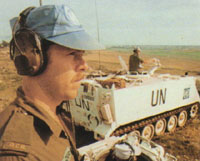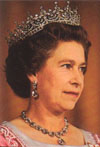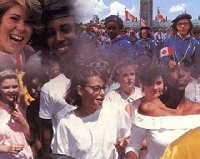● Welcome
to Canada/Bien Venu Au Canada
● The
Regions of Canada
● The
North
● The
West
● The
Prairies
● Central
Canada
● The
Atlantic Region
● History
● What's
in a Name?
Text
Welcome to Canada/Bien Venu Au Canada
 |
| Canadian Soldiers in UN
Peacekeeping Missions |
 In
size, Canada is the second largest country on earth. In terms
of economic power, it is a member of the Big Seven, the world's
leading industrial nations, ranking along with the United
States, France, the United Kingdom,
Italy, Germany and Japan. Canada plays an active role in international
affairs,
often taking part in peacekeeping
and
humanitarian
missions
and spearheading
aid
and development programs. Its scenery of mountains,
oceans, forests and prairies
is spectacular. It
has a lively and rich culture, with many world famous actors,
pop stars and writers. In
annual "quality of life" surveys produced by the United Nation
each year, Canada regularly is rated as having the best standard
of living in the world because of its health care, education,
clean environment, social welfare, and so on. In
size, Canada is the second largest country on earth. In terms
of economic power, it is a member of the Big Seven, the world's
leading industrial nations, ranking along with the United
States, France, the United Kingdom,
Italy, Germany and Japan. Canada plays an active role in international
affairs,
often taking part in peacekeeping
and
humanitarian
missions
and spearheading
aid
and development programs. Its scenery of mountains,
oceans, forests and prairies
is spectacular. It
has a lively and rich culture, with many world famous actors,
pop stars and writers. In
annual "quality of life" surveys produced by the United Nation
each year, Canada regularly is rated as having the best standard
of living in the world because of its health care, education,
clean environment, social welfare, and so on.
 In
contrast to its physical size, economic power and international
prestige,
Canada's population is very small. The current population
is about 30.6 million—about the same as the Chongqing city!
This
paradox
of
having a small number of people in a very large, resource-rich
area gives
rise to some
of the misleading perceptions
people
have about Canada. In
contrast to its physical size, economic power and international
prestige,
Canada's population is very small. The current population
is about 30.6 million—about the same as the Chongqing city!
This
paradox
of
having a small number of people in a very large, resource-rich
area gives
rise to some
of the misleading perceptions
people
have about Canada.
|
|
|
Life
in a High Arctic Village
|
 Most
people do not know very much about Canada. Mention
the country and usually one of two images will spring
to
mind. On
the one hand, you might picture a sparsely
populated,
frozen country where people
live in igloos,
eat
fish, hunt bears and constantly endure
snow
and cold. On the other, you might think Canada
is a country that is "just like America." Even Americans
are inclined
to think of Canada as the 51st state,
a part of America that through some quirk
of
history is not one (or more) of the United States' states. Most
people do not know very much about Canada. Mention
the country and usually one of two images will spring
to
mind. On
the one hand, you might picture a sparsely
populated,
frozen country where people
live in igloos,
eat
fish, hunt bears and constantly endure
snow
and cold. On the other, you might think Canada
is a country that is "just like America." Even Americans
are inclined
to think of Canada as the 51st state,
a part of America that through some quirk
of
history is not one (or more) of the United States' states.
 It
is easy to understand how such misleading impressions
of Canada have become engrained.
It is true that most of Canada lies very far north. Large
tracts
of the country are wild, virtually
unpopulated Arctic tundra,
full of dangerous animals and freezing temperatures. But most
Canadians live in the south of the country, along the 49th
parallel:
about 90 per cent of the population is estimated to live within
a few hundred kilometres of the Canadian-American border,
in an climate that is much less extreme. It
is easy to understand how such misleading impressions
of Canada have become engrained.
It is true that most of Canada lies very far north. Large
tracts
of the country are wild, virtually
unpopulated Arctic tundra,
full of dangerous animals and freezing temperatures. But most
Canadians live in the south of the country, along the 49th
parallel:
about 90 per cent of the population is estimated to live within
a few hundred kilometres of the Canadian-American border,
in an climate that is much less extreme.
 Canadians
and Americans are friendly neighbours, and Canadians frequently
visit the US to do such mundane
things as buy cigarettes and alcoholic drinks and gas for
their cars—these things are less expensive in the US, where
government taxes are lower. Most Canadians speak American-sounding
English (although if you are alert,
you can tell the difference between a Canadian accent and
an American one), eat hamburgers, wear jeans, play baseball
and enjoy American television shows. And nowadays, many "American"
TV shows and movies are actually filmed on location
in Canadian cities and towns, which can look just like the
US, but where labour costs are lower. It is no surprise that
people often assume that Canadians are just like Americans. Canadians
and Americans are friendly neighbours, and Canadians frequently
visit the US to do such mundane
things as buy cigarettes and alcoholic drinks and gas for
their cars—these things are less expensive in the US, where
government taxes are lower. Most Canadians speak American-sounding
English (although if you are alert,
you can tell the difference between a Canadian accent and
an American one), eat hamburgers, wear jeans, play baseball
and enjoy American television shows. And nowadays, many "American"
TV shows and movies are actually filmed on location
in Canadian cities and towns, which can look just like the
US, but where labour costs are lower. It is no surprise that
people often assume that Canadians are just like Americans.
 This
introduction opens with one of the things that makes Canada
distinctively
different—a welcome to Canada in the two official languages
of English and French. This
is our first clue as to what makes Canada special.
If
people outside of Canada are a little bit confused about what
Canada is, the same is also true for Canadians.
Writers, politicians, educators, sociologists
and ordinary Canadians spend a lot of time, effort and money
worrying about what exactly is "the Canadian identity."
What
makes a Canadian Canadian? How is Canada different
from the United States, with whom it has so much in common
in cultural, economic and physical terms? How
is it different from Great Britain, which gave the country
its political institutions,
its
territory,
its
laws, and even its Royal Family? And what
does an English-speaking wheat farmer in rural Saskatchewan
have in common with a French-speaking corporate
lawyer in the sophisticated city of Montreal?
Or
a second-generation Canadian dentist
who
traces her roots back to Guangdong and has been brought up
speaking Cantonese as well as English and French?
As Canada matures,
its cultural
make-up
becomes more varied and the question of what a Canadian
actually is becomes more, rather than less, complicated. This
introduction opens with one of the things that makes Canada
distinctively
different—a welcome to Canada in the two official languages
of English and French. This
is our first clue as to what makes Canada special.
If
people outside of Canada are a little bit confused about what
Canada is, the same is also true for Canadians.
Writers, politicians, educators, sociologists
and ordinary Canadians spend a lot of time, effort and money
worrying about what exactly is "the Canadian identity."
What
makes a Canadian Canadian? How is Canada different
from the United States, with whom it has so much in common
in cultural, economic and physical terms? How
is it different from Great Britain, which gave the country
its political institutions,
its
territory,
its
laws, and even its Royal Family? And what
does an English-speaking wheat farmer in rural Saskatchewan
have in common with a French-speaking corporate
lawyer in the sophisticated city of Montreal?
Or
a second-generation Canadian dentist
who
traces her roots back to Guangdong and has been brought up
speaking Cantonese as well as English and French?
As Canada matures,
its cultural
make-up
becomes more varied and the question of what a Canadian
actually is becomes more, rather than less, complicated.
 |
|
Queen
Elizabeth II of U.K.
|
 |
| The Canadian
Mosaic |
 This
search for a national identity underlies
the story of Canada. It is perhaps a natural thing to search
for in a country that is so new (Canada
first became a political entity
in 1867; and did not assume
its present shape until 1949). Canada is a former
colony that traces its history, its loyalties
and many of its settlers and forefathers
to "the Old Country", that is, Great Britain. And
when it gained its independence from Britain, it naturally
fell under the influence of its large, powerful neighbour
to the south with which it has so much in common.
Now,
its policy of actively encouraging immigration and assisting
different cultures to maintain their distinctive languages
and identities in Canada means that the forging
of
a "Canadian" identity that applies to everybody
and that everyone is happy with continues to be Canada's major
challenge. This
search for a national identity underlies
the story of Canada. It is perhaps a natural thing to search
for in a country that is so new (Canada
first became a political entity
in 1867; and did not assume
its present shape until 1949). Canada is a former
colony that traces its history, its loyalties
and many of its settlers and forefathers
to "the Old Country", that is, Great Britain. And
when it gained its independence from Britain, it naturally
fell under the influence of its large, powerful neighbour
to the south with which it has so much in common.
Now,
its policy of actively encouraging immigration and assisting
different cultures to maintain their distinctive languages
and identities in Canada means that the forging
of
a "Canadian" identity that applies to everybody
and that everyone is happy with continues to be Canada's major
challenge.
|

